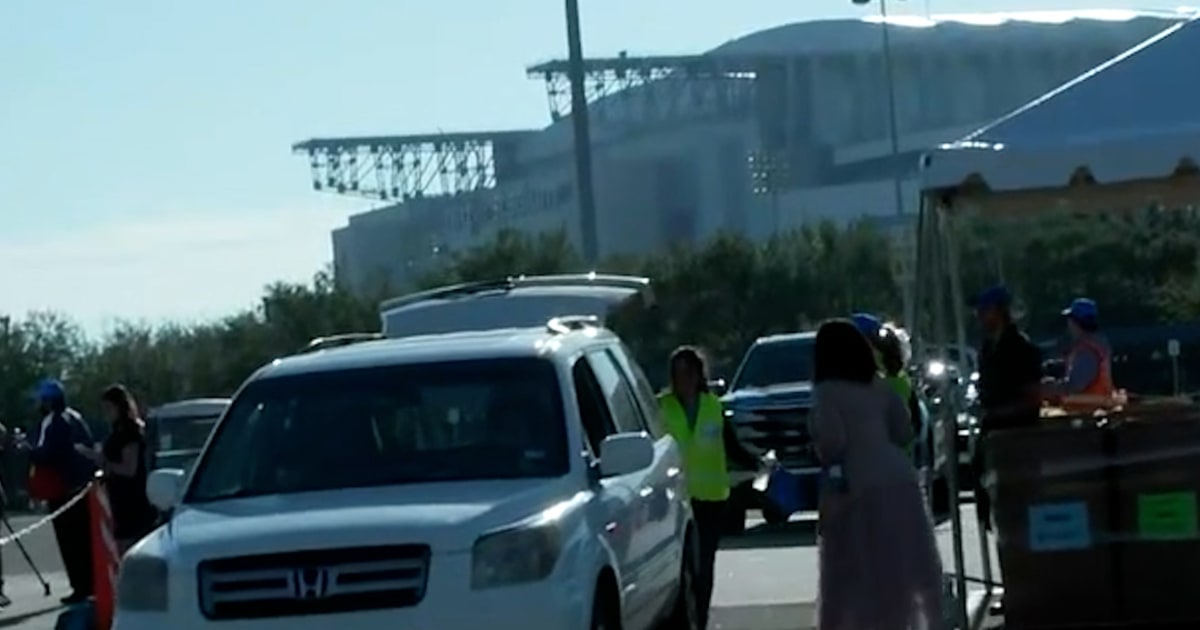That is the seventy fifth yr that costumed children are asking not just for sweet however trick or treating for UNICEF to assist youngsters in want. This system has raised over $200 million because it started.
UNICEF USA
conceal caption
toggle caption
UNICEF USA
Yearly, Halloween sparks the sale of $3.9 BILLION on sweet in the US. However that is not the one spectacular statistic associated to trick-or-treating.
A number of years after World Battle II, a pair in Philadelphia, Pennsylvania, had an concept — what if children additionally requested for cash to donate to UNICEF, the U.N. company that protects the rights of youngsters worldwide. This yr marks the seventy fifth anniversary of that initiative, referred to as Trick-or-Deal with for UNICEF. And a few $200 million has been collected throughout that point span.
This yr’s marketing campaign options supermodel Heidi Klum, considered one of an esteemed group of previous and current movie star supporters like Jennifer Lopez, Zendaya, Sammy Davis Jr., Maya Angelou, Bob McGrath and even Lassie.
“We wish to elevate consciousness for the significance of defending youngsters — ensuring they’re wholesome, that they are effectively fed,” says Shelley Diamond, a spokesperson with UNICEF USA.
However in 2025, it is not simply the anniversary that is of be aware. At a time of a dramatic and abrupt scaling again of federal overseas support, some say this straightforward follow is extra vital than ever.
“We now have completely ample assets to guarantee that [children’s] rights are revered,” says Charles Kenny, a senior fellow on the Middle for World Growth assume tank in Washington, D.C. “However frankly, governments worldwide, together with the US, have failed in that.”
He believes that in an imperfect world, it is best to assist these in want nevertheless we will. And that features Trick-or-Deal with for UNICEF, which Kenny lauds as “a unbelievable win” — one which has the additional advantage of getting children inquisitive about “their fellow youngsters worldwide.”
An concept that captured the nation
The origin of this system goes again to the late Nineteen Forties. After World Battle II, starvation stalked giant swaths of the globe, together with Europe and elements of Asia. A Presbyterian pastor on the time, Clyde Allison and his spouse, Mary Emma, believed within the energy of neighborhood service. When Mary Emma noticed well-fed American children trick or treating on Halloween, she had an concept.
Monroe Allison, her son, remembers her pondering. “These children could possibly be doing one thing actually significant as an alternative of simply amassing sweet for themselves,” he says. “So it was my mom who demanded of my father, ‘We now have to transform this into one thing good.'”
“Their hearts yearned to have the ability to have these children acquire cash for youths who wanted it,” provides Diane Allison, Monroe’s spouse. “It is vitally vital due to that have of empathy for different youngsters — the ability to do one thing.”
And so the Halloween collections have been born. The Allisons organized youngsters from church Sunday faculties to collect footwear, winter coats, cleaning soap and cash for youths in want elsewhere on this planet. For the primary couple of years, the Church World Service, a faith-based group that responds to international starvation and poverty, distributed the products.
After connecting with philanthropist Gertrude Ely and first girl Eleanor Roosevelt, the Allisons quickly acknowledged that UNICEF was a great charity to accomplice with. And by 1951, Diane says the company had reworked the nascent concept right into a nationwide program of coin amassing.
The marketing campaign concerned orange assortment containers (usually transformed milk containers), public service bulletins, and songs together with the one Diane wrote. “Trick-or-Deal with for UNICEF, that is what we are saying… Youngsters serving to children in the entire world at the moment,” she croons throughout her interview with NPR.
“Youngsters serving to each other”
This system was a success. “Trick-or-Deal with for UNICEF zoomed like a wildfire,” says Monroe Allison. “And the youngsters who take part in it — and that is my mother and father’ concept — get as a lot out of this because the folks receiving it.”
One such recipient is Manyang Kher, one of many misplaced boys of Sudan, who fled his dwelling within the early Nineties throughout his nation’s civil conflict. He landed in a refugee camp in Ethiopia the place he lived for 13 years. “Our mother and father weren’t there with us,” he says.
Kher remembers UNICEF offering him and different youngsters with meals and college provides. These have been gadgets, he was advised, that got here from American youngsters.
“I do know there was some child serving to us from New York or someplace there,” he says. “It’s extremely excit[ing] to listen to, ‘Oh, there’s lots of children that wish to assist youngsters in refugee camp.’ To see child serving to child, youngsters serving to each other.”
Kher credit these presents with serving to him get vital energy as a boy — and an training.
“Hope, that is what it imply for me on the time,” he says. “To assist youngsters be higher human being, and that’s what creates society.”
This system enters a brand new and unsure period
Trick-or-Deal with for UNICEF started a decade earlier than the institution of the U.S. Company for Worldwide Growth, which went on to offer a wide selection of humanitarian support and improvement packages throughout the globe. It now seems to have outlasted the overseas support company, which the Trump administration rapidly dismantled.
However Kenny says the UNICEF marketing campaign reveals longstanding American assist for worldwide support. “This program has been operating for 75 years for a cause, proper?” he asks. “It is that lots of Individuals actually do care, regardless of what is going on on in Washington. It is much more vital than ever that Individuals arise and be counted in that approach.”
The U.S. remains to be the biggest overseas support donor worldwide in absolute {dollars}. (Although, Kenny notes, “in the event you put it on a per capita degree or as a proportion of GDP,” different nations high the listing.) However international want far outweighs that assist.
In accordance with Kenny, that is the place the UNICEF program can play a job. “It gives a number of the financing and a number of the consciousness, and we’d like each,” he says. “I hope that, as that is youngsters we’re speaking about, once they develop up and begin operating the federal government themselves, it is a signal that the long run will look somewhat extra beneficiant than at the moment.”
And it is a follow that has thrived from era to era. Beverley Weiler, age 75, remembers trick or treating for UNICEF as a child. On Halloween, she and her Quaker mates arrange a desk of their Santa Fe neighborhood with info, dolls from totally different nations and pumpkin soup — in order that youngsters and households can study this system and do it themselves. She says the wants of the world are extra seen than ever, together with to youngsters — and Trick-or-Deal with for UNICEF gives an antidote.
“It provides them someplace to put down their worries somewhat,” Weiler says, “and provides them one thing optimistic and productive to be part of that is sensible in a world that usually would not make sense.”




:max_bytes(150000):strip_icc()/GettyImages-2176694300-ae8ac7922e1542e587df999d107f912d.jpg)




:max_bytes(150000):strip_icc()/Health-GettyImages-1399211781-318c9a9a1a894d1493d62cec4933edba.jpg)













